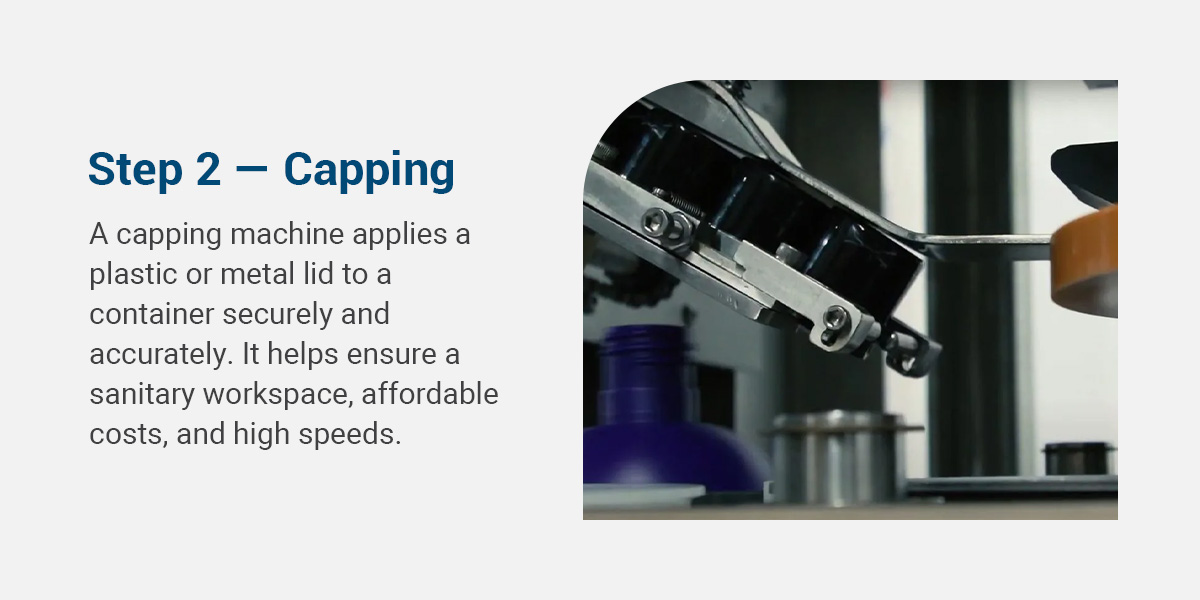04 May 2023 //
Liquid bottling is a meticulous, repetitive process comprising many steps. You can likely see why manufacturing companies around the globe have turned to automation for their packaging needs.
Automated liquid bottling solutions are an excellent way to reduce manual labor and error, ensure organized workstations, and lower costs. Explore the different liquid bottling steps in this guide.
How the Bottling Line Process Works
Many industries rely on liquid bottling solutions daily, from pharmaceuticals and cosmetics to beverage production. Below are the basic steps for filling, capping, labeling, and organizing bottled liquid products using automated technology.
Step 1 — Filling
A liquid packaging machine fills products with different liquid viscosities into containers. Liquid products can range from thin and watery to extremely thick. For instance, filling a tube of ointment differs vastly from filling a can with soda. Therefore, they require different filling approaches.
Besides viscosity, the right liquid filler machinery depends on a few other factors. Filling technology varies by container type, desired filling accuracy, packaging environment temperature, chemical compatibility of containers and products, particulate sizes in products, and more.
Types of Commercial Bottle Filling Machinery
There are multiple types of liquid filling machines, such as:
- Inline fillers: An inline liquid filling machine uses a conveyor system to fill containers in a continuous line. These systems feature various filling nozzles to accommodate different production requirements. They’re cost-effective, flexible, and adjustable, making them ideal for various containers and products. Companies with low to medium manufacturing rates often choose inline fillers, as they enable simple defect detection.
- Rotary fillers: Compared to inline liquid fillers, rotary liquid filling machines are generally larger and faster. They feature many filling heads that fill bottles at high speeds, yielding significantly more containers per minute. Additionally, many rotary machines incorporate bottle cleaning and capping technology. However, both rotary and inline fillers are quick, convenient solutions for businesses looking to speed up overall production.
- Monoblock fillers: A monoblock filling system combines multiple packing equipment pieces on the same chassis or frame. It often includes a filling machine and capping or sealing equipment. Typically, a monoblock filler has a star wheel that moves containers from one packaging equipment piece to another. Compared to long, complex traditional conveyors, a single star wheel occupies far less space. Monoblock systems are especially ideal for facilities with space limitations.
Regardless of the machine type, they follow the same basic filling steps. In an automatic system, the container travels through the machine on a conveyor. After the machine fills the bottle, it’s ready to move on to the next stage.
By accelerating filling and reducing tedious human labor, a liquid packaging machine promotes high quality, accuracy, and efficiency.
Step 2 — Capping
A capping machine applies a plastic or metal lid to a container securely and accurately. It helps ensure a sanitary workspace, affordable costs, and high speeds.
Through a feeder system, closures such as caps, lids, or plugs move into the cap hopper. Then, the cap elevator feeds the closures into a sorting bowl. A sorting bowl helps ensure a more efficient cap delivery system.
Closures are organized in the sorting bowl, then sent to the capping machine to be attached to the container. For some applications, a cap sorter or hopper can eliminate the need for a sorting bowl.
Capping machines come in many shapes and sizes to accommodate various caps and containers. They can range from small, low-speed, and semi-automatic to large, fully automatic, and high-speed systems.
Two common types of cappers are:
- Single-head: A single-head capper system stops containers at stations to secure lids. While usually designed to be inline, a single-head capper can also include a star wheel that removes the cap and bottle from the line. The star wheel secures the lid before sending the parts back to the line.
- Rotary chuck: A rotary chuck capper places caps onto the containers, then sends them through the machine to seal them. The machine’s moving parts spin the bottle and cap to form a secure seal.
Step 3 — Labeling
Once the cap has been tightened and secured, it’s time to label the container. Labeling application machinery uses a conveyor system to label containers at consistent speeds. It typically includes a drive wheel, reel, and labeling wheel.
The drive wheel drags the label belt, pulling the label tape out of the spool. The label wheel presses against the bottle. The reel’s open-loop displacement control maintains label strip tension. Because the labels are closely connected on the label strip, the label belt must stop and start continuously.
The label attaches to the bottle while the wheel and container move at the same speed. When the conveyor reaches a certain position, the drive wheel accelerates to match the conveyor’s speed. The machine decelerates to a stop once labeling is complete.
The label might slip slightly, so it usually has a special mark and sensor to ensure correct placement. During deceleration, the drive wheel can readjust the position to correct any errors on the label.
Like filling and capping machines, labeling solutions provide many benefits like high speeds, improved efficiency, and visually attractive final products.
Step 4 — Orienting
The final step is orienting the product. Containers often arrive at the packaging line haphazard and disoriented. The bottles must be converted from random to uniform orientation for packaging.
A bottle orientation machine helps ensure all containers move down the production line in the same position. It rotates and turns any incorrectly positioned containers to the proper orientation. The type of container and direction it must be turned will determine the required machine type.
Many orientation machines only orient containers vertically. In some cases, axial container orientation is needed after vertical orientation. A secondary or axial orientation machine can accomplish this step.
Orientation is particularly useful for containers with handles or non-centered openings, such as laundry detergent containers. An orientation machine can ensure the container’s handle side is always on the left or right, thus aligning the off-centered opening with the filler nozzle.
Orientation technology can accommodate a range of irregularly shaped liquid containers, including trigger spray bottles, honey bear bottles, and many more.
Create a Custom Bottling Operation for Your Product
At DTM Packaging, we specialize in customized automation solutions for packaging applications. Operating from our facility just outside of Boston, we manufacture and remanufacture packaging and bottling equipment to meet clients’ unique needs.
Integrating either all new equipment or remanufactured machinery, we offer everything from single pieces of specialized packaging equipment to full packaging lines. Our packaging machinery is highly durable, incredibly efficient and easy to operate, adding speed and value to your company’s packaging system.
From initial design to final installation, we deliver high-quality service and packaging every step of the way. Contact us today to begin your customized bottling solution process.





